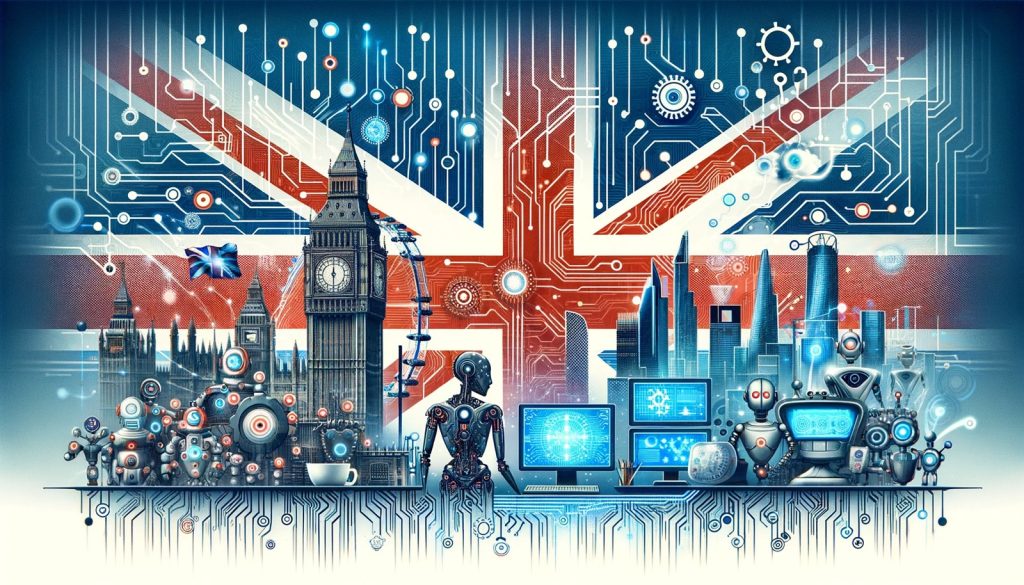The Impacts of AI on Employment in the UK: Navigating the Future
The Dawn of the AI Era and Its Implications for the UK Workforce
The onset of the Artificial Intelligence (AI) era heralds a transformative period in human history with profound implications for the labor market. As industries embrace AI, job security and workforce displacement concerns have surged. The United Kingdom, a global leader in technological adoption, finds itself at the crossroads of this transition. A pivotal report from the Institute for Public Policy Research (IPPR) suggests that up to 8 million jobs in the UK could be at risk due to AI and automation. This analysis seeks to unpack the nuances of the IPPR’s findings, exploring the multifaceted impact of AI on various sectors and demographics and proposing pathways toward a sustainable integration of AI in the workforce.
Let’s start by talking about how Artificial Intelligence (AI) is changing jobs in the UK. We’ll look at the big picture, including technology trends, what it means for society, and the challenges and opportunities for businesses, employees, and government.
Introduction
As we stand on the brink of a new era defined by rapid advancements in Artificial Intelligence (AI), the contours of the global job market are undergoing a seismic shift. The proliferation of AI technologies promises to usher in a new age of efficiency and innovation. Still, it also casts a long shadow over the future of work, particularly in developed economies such as the United Kingdom. With its robust economy, strong tradition of technological innovation, and diverse workforce, the UK finds itself at a critical juncture. The question of how AI will reshape the landscape of employment is not just an economic or technological issue but a societal one, touching upon themes of equity, security, and human dignity.
The narrative of technological progress is as old as civilization itself, but the speed and scope of AI’s rise are unprecedented. From machine learning algorithms that can predict consumer behavior to autonomous systems that revolutionize manufacturing, the applications of AI are vast and varied. However, alongside the marvels of AI come challenges, most notably the potential displacement of millions of jobs. A landmark report by the Institute for Public Policy Research (IPPR) in the UK serves as a clarion call to the nation, highlighting the urgent need to address the impact of AI on employment. According to this report, up to 8 million jobs in the UK are at risk of being automated away, presenting a stark vision of the future that necessitates immediate and thoughtful action.
This introduction to the complex world of AI and its implications for the UK job market aims to unravel the nuances of the debate surrounding AI and employment. It seeks to explore not only the risks and challenges posed by AI but also the myriad opportunities it presents for reshaping work in ways that enhance human capability and creativity. As we delve deeper into the sectors most affected, the demographics most at risk, and the strategies for navigating this new technological landscape, it becomes clear that the advent of AI is not merely a challenge to be met but an opportunity to reimagine the very nature of work itself.
In the following discussion, we will explore the core findings of the IPPR report, analyze the sectors and demographics most vulnerable to AI-driven displacement, and propose strategies for ensuring that the transition to an AI-enhanced job market is both equitable and beneficial. The goal is to provide a comprehensive overview that balances the potential drawbacks of AI with its capacity to drive innovation and prosperity, underscoring the importance of proactive adaptation and strategic planning in harnessing the full potential of AI for the betterment of society.
The Core Findings of the IPPR Report
The IPPR’s investigation into AI’s impact on employment is comprehensive and revealing. It underscores the imminent threats and opportunities AI presents across different segments of the workforce. The report categorizes jobs into various levels of risk based on their susceptibility to automation, highlighting a future where the employment landscape could be drastically altered.
Sectors at Risk (Detailed Analysis)
- Administrative and Secretarial Roles: The report illuminates how roles involving routine administrative tasks are highly susceptible to AI-driven automation. For instance, AI systems can now manage schedules, respond to emails, and handle data entry tasks more efficiently and lower costs than human employees.
- Part-time and Entry-level Positions: These roles often serve as stepping stones for individuals entering the workforce. However, the simple and repetitive tasks in these jobs make them prime candidates for automation. The displacement of these roles could significantly hinder the job market entry for young professionals.
- Customer Service: The evolution of AI chatbots and virtual assistants has revolutionized customer service. These AI systems can handle a wide array of customer queries without fatigue, error, or the need for breaks, posing a direct threat to human jobs in this sector.
Demographics in Focus (In-depth Exploration)
- Women: The gendered impact of AI job displacement is particularly concerning. With a significant proportion of women employed in sectors like administration, which are highly automatable, the economic independence and career progression of women are at risk.
- Youth: Young job seekers, often looking for part-time or entry-level opportunities, face an increasingly competitive market where AI systems could fulfill many roles they would typically fill.
- Low-wage Workers: These individuals are disproportionately affected by AI adoption. Their jobs, primarily characterized by routine tasks, are among the first to be automated, leading to an urgent need for re-skilling and up-skilling.
The Double-edged Sword of AI Adoption (Further Insights)
AI’s impact on the workforce is a complex narrative of doom. The technology harbors the potential to drive innovation, create new job categories, and elevate the nature of work itself. However, realizing these benefits while mitigating the adverse effects requires strategic foresight and action.
Opportunities Arising from AI
- Job Creation in Emerging Fields: Beyond the immediate threat to existing jobs, AI catalyzes new professions. Roles in AI ethics, machine learning development, data protection, and user experience design are emerging rapidly, offering new avenues for employment.
- Enhancement of Existing Jobs: AI can free workers from routine tasks, letting them concentrate on more important work that requires creativity, strategic planning, and social skills. For example, doctors and medical professionals can leverage AI for diagnostics, dedicating more time to patient care.
- Increased Productivity: AI’s ability to improve efficiency can drive economic growth. Fields like manufacturing, logistics, and supply chain management could greatly benefit from AI, potentially leading to new job creation.
Strategies for Mitigation and Adaptation (Comprehensive Strategies)
The transition towards an AI-integrated workforce is fraught with challenges but also ripe with opportunities. A proactive approach, encompassing education, policy-making, and corporate responsibility, is essential to navigate this shift effectively.
- Skills Development and Education: A future-ready workforce is one that is adaptable and equipped with the skills necessary for the AI era. Educational curriculums need to be overhauled to include AI literacy, digital skills, and critical thinking. Lifelong learning and continuous professional development should become the norm.
- Government Policies and Safety Nets: Governments have a pivotal role in cushioning the blow for workers displaced by AI. This could include policies like a universal basic income, tax incentives for companies investing in employee retraining, and support for transitioning into new careers.
- Corporate Social Responsibility: Businesses that benefit from AI adoption have a moral obligation to ensure their employees are not left behind. This includes investing in training programs, creating new opportunities within the company, and fostering a culture that values human contribution alongside technological advancement.
Conclusion
The IPPR report serves as a crucial indicator of the urgent need to address the workforce implications of AI and automation. As the UK, along with the rest of the world, ventures further into this new technological epoch, the actions taken today will shape the future of work for generations. Embracing AI with a balanced approach that values both innovation and human capital is key to forging a prosperous, equitable future where technology serves as a bridge to new opportunities rather than a barrier to employment. Ensuring that the workforce is prepared, protected, and poised to benefit from AI is not just a policy challenge—it’s a societal imperative.







